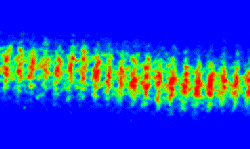When the Atom Falls Apart

Atoms may soon be available in fractional form. When specially prepared atoms are lined up in a one-dimensional array, the number of atoms at one of the sites can be fractional, according to the 6 May print issue of PRL. The atoms have to be prepared as a Fermi-Dirac gas–similar to a Bose-Einstein condensate–and an external electromagnetic field needs to be applied, but the researchers say the experiment could be possible in the near future.
Fractional electrons are old news. First, researchers found that when the polymer polyacetylene acquires an extra electron, the particle seems to split into two quasi-particles, or excitations of the molecule as a whole. One carries spin and the other charge. There’s also the fractional quantum Hall effect: electrons trapped between two semiconductor surfaces can appear as quasi-particles with charges less than those of single electrons. Both examples depend on collective behaviors emerging from the whole system, and the atomic version is no different in this respect.
Janne Ruostekoski of the University of Hertfordshire, UK, and his colleagues say the first step in making fractional atoms is to chill a cloud of spin-1/2 atoms to its coldest possible state, a Fermi-Dirac gas. (Spin-1/2 atoms have half a unit of intrinsic angular momentum; the coldest state for a gas of spin-0 atoms is a Bose-Einstein condensate.) Some of the atoms should be spin up and others spin down. Next, sprinkle these onto an optical lattice–a standing laser-light wave that traps atoms like eggs in an egg carton. The lattice needs two components: one set of sites that trap spin up atoms, and a second set of sites, interleaved with the first set, that trap only spin down atoms.
The final piece is an additional oscillating, electromagnetic standing wave which is nearly constant over the entire lattice, except that the left portion of the field is always negative whenever the right portion is positive. The point in the middle of the lattice where the field switches sign is called a phase kink, and it’s similar to the “node” you see in the middle of a long jump rope twirled in the mode with two “lobes.” This additional field provides the energy for atoms to flip from spin down to spin up and back again, allowing them to jump from site to site in the lattice.
According to the team’s equations, any measurement of the number of atoms at the kink lattice site will yield a fractional value. The exact mechanism is rather mysterious to them now, but they believe that some fraction of the quantum mechanical wave function describing the kink atom is smeared out across the whole system. The remaining fraction of the atom stays at its lattice site. To detect the fractional atom, researchers could scatter light off the gas near the kink or use a magnetic field to detect the spins, according to the paper. Ruostekoski and his colleagues say the same effect should also be possible in two- and three-dimensional lattices.
Setting up the proposed experiment should be possible, says Brian Anderson of the University of Arizona in Tucson, but detecting the fractional atoms “will require some fancy and clever experimental tricks.” Still, the measurements “should be feasible, and would almost certainly lead to interesting results.”
–JR Minkel
JR Minkel is a freelance science writer in New York City.


